七年级上册集体备课Unit5教学案
- 格式:doc
- 大小:908.00 KB
- 文档页数:18
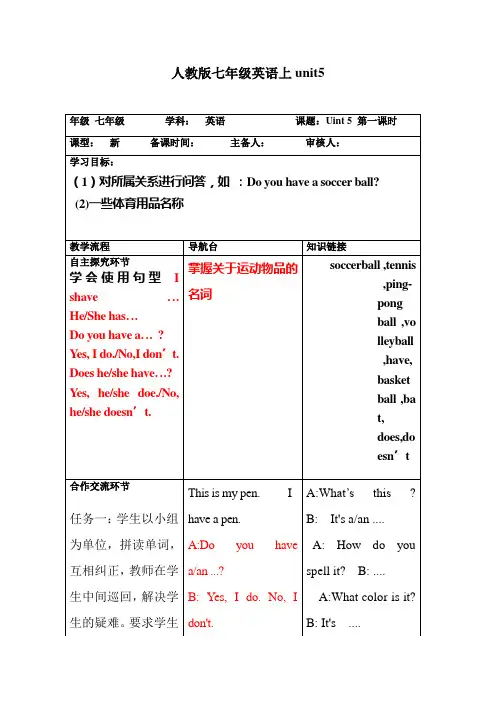
人教版七年级英语上unit5年级七年级学科:英语课题:Uint 5 第一课时课型:新备课时间:主备人:审核人:学习目标:(1)对所属关系进行问答,如:Do you have a soccer ball? (2)一些体育用品名称教学流程导航台知识链接自主探究环节学会使用句型I shave …He/She has…Do you have a…?Y es, I do./No,I don’t. Does he/she have…? Y es, he/she doe./No, he/she doesn’t.掌握关于运动物品的名词soccerball ,tennis,ping-pongball ,volleyball,have,basketball ,bat,does,doesn’t合作交流环节任务一:学生以小组为单位,拼读单词,互相纠正,教师在学生中间巡回,解决学生的疑难。
要求学生This is my pen. Ihave a pen.A:Do you havea/an ...?B: Y es, I do. No, Idon't.A:What’s this ?B: It's a/an ....A: How do youspell it? B: ....A:What color is it?B: It's ....能准确的拼读单词,敢于领读单词。
放到早读任务二:要求学生能运用本节课所学的单词进行会话练习。
展示点拨环节完成听力练习1b,2a,2b,并根据听力对话进行自由交际要求学生会用第三人称he或she 造句,编对话。
并在此基础上,让小组进行竞争比赛He has a/an…Does he have a/an…?Yes, he does. No,he doesn’t.Sh e has a/an…Does she havea/an…?Yes, shedoes. No, shedoesn’t1.注意助动词do/does的使用。

2020年九年级下学期英语课教案秦艳一、课题:七年级上册Unit5 Do you have a soccer ball?二、课型:复习课三、教学目标:【知识与技能】:1.复习、巩固单词、短语2.理解、掌握由Do引导的一般疑问句的构成及其回答3.掌握动词第三人称单数的变化规则及用法【过程与方法】:引导学生通过归纳、对比的方法,加深对知识的掌握。
【情感态度与价值观】:引导学生主动记笔记,培养专注听课的能力。
四、教学重难点:1.教学重点:复习重点单词、短语;掌握动词第三人称单数的变化规则及用法2.教学难点:理解、掌握由Do引导的一般疑问句的构成及其回答五、教学用具:班班通平台;教科书六、教学过程:1.与学生问好2.复习单词听录音,跟读单词(教师注意听,读完后纠错;注意监督学生朗读情况,及时提醒)3.语法讲解(1)请学生观察本单元标题:Do you have a soccer ball?此句子为:由Do引导的一般疑问句(提示学生与上节课讲的由Be动词引导的一般疑问句作比较)构成:Do+you+动词原形+其他?回答:Yes, I do.No, I don’t.Does+he/she+动词原形+其他? 回答:Yes, he/she does.No, he/she doesn’t.(2)请学生观察语法聚焦中的句子,注意对比:I have a volleyball. She has a baseball.结论:当句子主语是第三人称单数时,谓语动词要有相应变化。
动词三单形式变形有三种:参考书本P914.重点短语、句子(1)短语:soccer ball足球;baseball bat 棒球拍;watch TV看电视;play computer games 玩电脑游戏;at school在学校;after class 课后(2)句子:Let’s go! 让我们走吧!Let me get it!让我去取!Let为使役动词,let sb. do sth.eg.:Let’s have lunch after class.5.当堂测验3道关于一般疑问句的选择题用展台展示,请学生思考并回答。
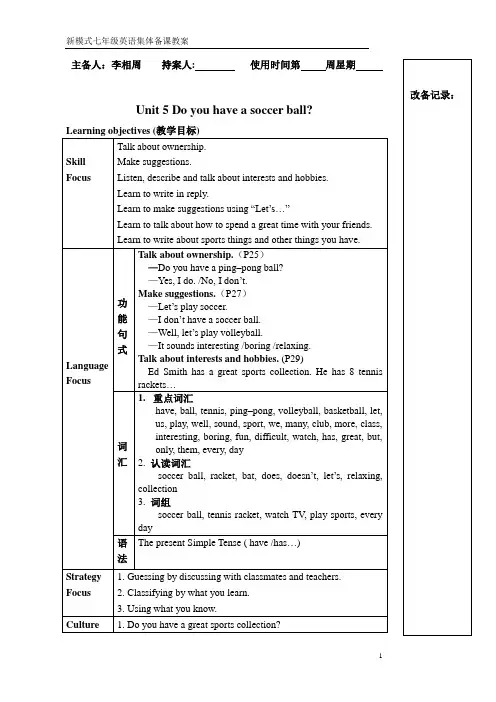
Unit 5 Do you have a soccer ball?Analyze and rearrange teaching materials (教材分析和重组)1. 教材分析本单元以“Do you have a soccer ball?”为话题, 共设计了三个部分的内容。
Section A该部分有4个模块:第一模块围绕“Do you have a soccer ball?”这一话题展开词汇学(1a)、听力(1b)、口语(1c)训练;第二模块继续围绕“Do /Does… have a…?”进行听力(2a-2b)、口语训练(2c);第三模块围绕“Make suggestions.”这一话题展开训练,训练形式为单词填空(3a)和角色表演谈论图画为训练形式(3b);第四模块就“Complete the forms according to the sports club you like.”以结对活动形式进行介绍。
Section B该部分有4个模块:第一模块是词汇的学习(1a)与运用(1b);第二模块仍然围绕(1a-1b) 的词汇进行听力训练(2a-2b)、围绕提建议进行口语训练(2c);第三模块继续围绕“Ownership”这一话题展开有关收藏品阅读(3a), 写作训练(3b-3c);第四模块仍就“Ownership”这一话题以口语训练形式展开全班活动。
Self Check该部分有3个模块:第一模块以填空形式对所学词汇进行训练;第二模块以默写已学过的五个单词的形式对所学的词汇继续巩固复习; 第三模块围绕有关ownership和suggestions对话开展口语训练和写作训练。
教材重组和课时分配Period 1 (Section A: 1a, 1b, 1c) New function presenting Period 2 (Section A: 2a, 2b, 2c, 3a, 3b, 4) PracticePeriod 3 (Section B: 1a, 1b, 2a, 2b, 2c) V ocabulary building Period 4 (Section B: 3a, 3b, 4)Integrating skills Period 5 (Self Check: 1, 2, 3 & Workbook) WritingTeaching procedures and ways (教学过程与方式)Period One New function presentingLanguage goals (语言目标)1. Words & expressions: have, soccer ball, tennis, racket, tennis racket,ping–pong, volleyball, basketball, bat (P25)2.Key sentences: Do you have a ping–pong ball?Yes, I do. No, I don’t. (P25)Ability goals (能力目标)Enable the students to understand and talk about ownership and make suggestions.Emotion & attitude goals (情感和态度目标)Enable the students to form positive attitude toward sports collection and love sports, keep healthy and learn to make suggestions politely. Strategy goals (策略目标)To understand the target language by reading pictures, drawing pictures, countingnumbers, drawing a chart.Culture awareness goals (文化意识目标)People’s attitude toward sports collections is different in English speaking countries.Teaching important points (教学重点)Talk about ownership and make suggestions.Teaching procedures & ways (教学过程和方式)Step 1. Revision and Lead-inAsk one or more students to show their homework.T: In the last unit, I ask you to do a project about filling in the chart because we want to have a ball game. But we don’t know what kind of balls you have. Please ask your classmates in the group what balls he /she has. Then write down the information in the chart. Now who wants to displayyour project on the blackboard?T: Do you have tennis? S: Yes, I do.Second point to the others in the classroom.T: Does Wang Wei have tennis? S: Yes, he does.Third point to Li Hong in the classroom who has ping–pong ball, but no tennis.T: Do you have tennis?S: No, I don’t.T: Do you have a ping–pong ball?S: Yes, I do.T: Does Li Hong have tennis?Ss: No, she doesn’t.T: Does Li Hong have a ping–pong ball?Ss: Yes, she does. Array T: Today we are going to learn how to talk about ownership and make suggestions.Step 2. Listing and SpeakingAsk the students to read the picture on Page 25.T: What can you see in the picture?Ss: We can see a ping–pong ball, a ping–pong bat, a tennis racket, a soccer ball, volleyball, a basketball, a TV, a computer game.T: Ask the students to match the words with the things in the picture.Ss: Say, Number 1 is (C), tennis racket. Number 2 is (a), ping–pong ball…After checking the answers in 1a, ask the students to read aloud the new words again and again, ask and answer about them in pairs. And then play the recording again. This time students listen to conversation and circle the words they hear. And then check the answers. Students circle ping–pong bat and computer game.Step 3. Pair workAsk the students to read the example conversation. Have students repeat. And then point to the television in the illustration and substitute that word in the conversation. Have students repeat again. And then ask students to practice the conversation in pairs and remind them to use various objects from the illustration. As students practice, move around the classroom to check progress and help with pronunciation.Ask for more ideas from the students and write their ideas on the blackboard.p hone, cars, pencil case, eraser, pen, book, dictionary, watch, key, notebook, ring, sister , brother, chair, bookcase, CD, video tape, hat, desk, dresser…Show the following to the students and then ask them to practice in pairs.—Do you have a phone?—Yes, I do.—Do you have a CD?—No, I don’t.T: Now work in pairs, make conversations with the newwords in 1a and act it out around the students.Sample conversations:1. S1: Do you have a ping–pong bat?S2: Yes, I do.S1: Do you have a ping–pong bat?S2: No, I don’t.2. S3: Do you have volleyball?S4: Yes, I do.S3: Do you have a basketball?S4: No, I don’t.3. S5: Do you have a tennis racket?S6: Yes, I do.S5: Do you have a TV?S6: No, I don’t.Step 4. Homework1. Ask the students to do more practice as required in 1 c on Page 25.2. Ask the students to prepare the next period. Think about the usage of―Does she /he have…?‖主备人:李相周持案人: 使用时间第周星期Period Two PracticeLanguage goals (语言目标)1. Words & expressions: does, doesn’t, let, us, let’s, play, well, sound,good, sport, we, many, club, more, class (P26)2. Key sentences:—Let’s play volleyball.—That sounds good. (P26)Ability goals (能力目标)Enable the students to make suggestions politely.Emotion & attitude goals (情感和态度目标)Train the Ss to make suggestions politely and take activity part in school sports club and keep healthy.Strategy goals (策略目标)Enable the students to match the problems and worries.Culture awareness goals (文化意识目标)Learn to how to make suggestions politely.Teaching important points (教学重点)Talk about making suggestions.Teaching procedures & ways (教学过程和方式)Step 1. RevisionBefore class, le t’s have a revision. First make up a conversation with ―Do you have…?”about ownership, and then in threes make up a conversation with ―Do you have…? Does she /he have…?‖Sample dialogues:1. S1: Do you have a soccer ball? S2: Yes, I do.S1: Do you have a basketball? S2: No, I don’t.2. S1: Do you have a computer game? S2: No, I don’t.S1: Do you have a ping–pong bat? S2: Yes, I do.S3: Does he have a computer game? S1: No, he doesn’t.S3: Does he have a ping–pong bat? S1: Yes, he does.Step 2. Listening PracticePlay the recording for the first time.T: Listen to the tape. You only listen.Play the recording for the second time. Then check the answers.T: You’ll hear the same conversation again in the picture. This time please listen for the names in the pictures, and then number the pictures (1-4).After that ask a few students to say out their answers in 2a.S1: The answers are 3, 1, 4, 2.S2: Number the pictures: 3, 1, 4, 2.Play the recording for the third time.T: You will hear the conversations for the third time. You are to match the people from activity 2a to the balls in the recording for the fourth time and then correct the answers.T: You listen to the tape and write the numbers from the pictures in 2b next to the correct balls.After doing listening, talk about the dialogue about 2b, and then ask some students to say out their answers in 2b.S3: The answers are 3, 2, 1, 4.S4: They are 3, 2, 1, 4.Step 3. Pair workLook at the things in the picture. Ask your partner if he /she has the things in 2c.Ask the students to act out the conversation in pairs.Sample conversations:1. S1: Do you have a dictionary? S2: Yes, I do.S1: Do you have an eraser? S2: No, I don’t.2. S3: Do you have a baseball? S4: No, I don’t.S3: Do you have a football? S4: Yes, I do.3. S5: Does Tom have volleyball? S6: Yes, he does.S6: Does Mike have a pen? S5: No, he doesn’t.Step 4. PracticeLook at 3a, point out the words in the box and then ask a student to read aloud the four words to the class.T: Fill in the blanks with the words from the box alone. I’m sure you’ll fill in the correct answers. And now who’ll tell me the answers? Please hand up if you know the answers. Oh, thank you, --------!S1: The answers are: 1. don’t,2. Let’s,3; have,4. soccer.T: You are right. Thank you. Now let’s practise reading aloud the conversations in pairs and act them out. And then tell the students how to make suggestions politely using “Let’s…!”For example:T: Let’s play ping–pong ball./ Let’s play tennis./ Let’s play volleyball…S: That sounds good.After finishing practising the conversations in 3a, ask the students to make conversations with their partners according to the pictures below in 3b. Ask the students to point to each one and describe each object. Show the students how to use the pairs of pictures as substitutes in the conversation.For example:T: Let’s play basketball.S: I don’t have a basketball.T: Well, let’s play football.S: That sounds good.Ask pairs of students to perform the conversation for the class and tell them how to make suggestions politely in 3b.Step 5. Writing and practiceThis activity gives students a chance to role play a conversation about sports. Students review the language of introductions, and then complete the form, introduce themselves to the coach.T: What sports do you like to play? Who are your favorite sportsmen and sports women? What sports are available at school?S1: I like to play football. My favorite sports man is Liu Xiang. Basketball and volleyball are available at our school.T: Our school has a sports Club with all the sport that you would like to play. If you would like to join the school sports club, please fill in the form with your personal information. When students have completed filling in the form, divide them into pairs.T: What’s your first name? What’s your last name? What sports do you like? Do you like…? What class are you in?S: My first name is Li. My last name is . I like ping–I’m in Class 4, Grade 7.Have students role play the conversation between a student and coach. Walk around the class and offer help where necessary.Step 6. SummaryAsk some students to sum up what we have learned key vocabulary and the target languages.Step 7. Today’s homeworkT: First make up dialogues with ―ownership and make suggestions‖ in pairs /in groups. Next class I’ll ask you to act them out. Second, prepare for the next class P 28 (1a, 1b, 2a, 2b, 2c). Array主备人:李相周持案人: 使用时间第周星期Period Three New vocabularyLanguage goals (语言目标)1.Words & expressions:interesting, boring, fun, difficult,relaxing, watch, watch TV (P28)2. Key sentences: (1) Let’s play computer games.(2) That sounds interesting. (P28)Ability goals (能力目标)Enable the students to learn to make suggestions politely and responses.Emotion & attitude goals (情感和态度目标)Enable the students to learn to express their feelings about different suggestions.Strategy goals (策略目标)Enable the students to know how to express their feelings aboutdifferent suggestions.Culture awareness goals (文化意识目标)Different countries, different suggestions.Teaching important points (教学重点)Learn to how to express different suggestions and responses. Teaching procedures & ways (教学过程和方式)Step 1. Revision and word studyCheck the homework:T: Last class we asked the students to make up conversationswith ―ownership and make suggestions‖in pairs /ingroups. Now we’ll ask you to act them out.Point to the five words and ask the students to repeat each one,and then point to the five pictures and ask the students tomatch each picture with one of the words in section B (1a).Ask the students to write the letter of the picture on the linenext to each word.Ask the students to say out the answers. Go around the room,asking students to point to a picture and say the word that goeswith that picture. The answers are: 1. c; 2. d; 3. e; 4. b; 5. a.Step 2. Guessing the wordsThis activity makes students practise using the vocabularywords from this unit. Point to the picture in 1a and reviewthe words.T: Now please draw pictures that show somethinginteresting, boring, fun, difficult or relaxing. Please showyour pictures to some of your classmates. Everyone triesto guess the meaning.Step 3. Listening and word studyBefore playing the recording for the first time, point out thefive words in 1a above and ask a student to read them aloudto the class.Play the recording for the first time in 2a.T: Listen to the tape carefully and remember the fourPlay the recording for the second time.T: Listen to the conversation and put a checkmark to the leftof each word in 1a that you hear.Ask the two students to say out their answers.Ss: The answers are: a. interesting; b. boring; c. fun;d. difficult;e. relaxing.Step 4. Listening and writingT: I’ll ask a student to read the name of each activity to theclass. And then I’ll play the tape. Listen to the tapecarefully for the first time and remember what Tony saysabout these activities. I’ll play the recording again. Thistime listen to the conversation and write the word in theblank.After listening to the tape for the second time, ask somestudents to read the same example to the class.Ss: The answers are: 1. interesting; 2. difficult; 3. boring; 4. fun.Step 5. Practice and actingBefore asking the two students to read the dialogues, listthese activities on the blackboard: play computer games,play volleyball, watch TV, play basketball.T: I’ll ask the two students to act out the dialogues, talkingabout the activities in 2b.One acts as Jenny, the other acts as Tony, move around theclassroom offering languages support and checkingprogress when the students talk about the activities. Ask afew pairs of students to perform their conversations for theclass.Sample dialogues:1. S1: Let’s play volleyball.S2: That sounds fun.2. S3: Let’s watch TV.S4: That sounds boring.Step 6. Summary1. This class we have learned how to make suggestions andresponses politely. We also have learned how to use somedescription adjectives.2. Prepare for the next class.Step 7. Today’s homework1. Make up dialogues about ―Make suggestions and responses‖.2. Prepare for the next lesson.Period Four Integrating skillsLanguage goals (语言目标)1. Words & expressions:has, great, collection, but, play sports,only,them, a great sports collection, tennis racket, soccer ball, onTV, everyday (P29)2.Key sentences: (1) Ed Smith has a great collection.(2) But he doesn’t play sports—he only watches them on TV.Ability goals (能力目标)Train the ability of the students about reading and writing.Emotion & attitude goals (情感和态度目标)Enable students to form wide interests and hobbies.Strategy goals (策略目标)Enable students to collect what they like.Culture awareness goals (文化意识目标)Enable students to understand different people have different interests and hobbies.Teaching important & difficult points (教学重点和教学难点)1. The plural form of noun.2. The Present Simple TenseTeaching procedures & ways (教学过程与方式)Step 1. RevisionFirst check the homework, and then ask a few pairs to act out the conversation about: Making suggestions and responses.T: Who can make up a dialogue about making suggestions and responses in pairs?S1: Let’s play football.S2: That sounds fun, but I don’t have a football.S1: Well, do you have a basketball?S2: Yes, I do.S1: Then let’s play basketball.S2: Oh, basketball is so different.S1: OK. Let’s play ping–pong ball.S2: That sounds boring. Let’s play computer game! Do you havea computer?S1: Yes, I do.S2: That sounds interesting.Step 2. ReadingBefore reading this magazine article, ask students to name everything they see in the picture (3a).T: Read the article by yourself, and then circle the vocabulary words that are about sports activities.Give examples such as a stamps collection or a coin collection.T: Please close your books, look at the overhead projector, listen tome carefully, and then fill in the blanks with the sports things in 3a. Pleasetell the students the answers.S1: 1. tennis racket; 2. basketball; 3. baseball; 4. soccer ball; 5. volleyballExplain the usage of the grammar and some key sentences, ask the students to retell the text next class.Step 3. Reading and writingBefore reading this article, ask students to name everything they see in the picture (3b). And then read the article to the class. Ask students to look at the picture and fill in the blanks by themselves. After that, let the students correct the answers in pairs. Ask three students to write their answers on the blackboard. (The answers are: 1. baseball; 2. basketball; 3. tennis rackets; 4. volleyball.)After finishing filling in the blanks, explain the usage of the Present Simple Tense, the plural form of noun and some key words, key sentences. Ask students to recite the text (3b).Step 4. Writing and SpeakingT: After finishing learning the articles about 3a and 3b, now you write about yourself. Talk about your hobbies and interests such as:What sports do you play?What sports things do you have?What other things do you do? And so on.After a while I’ll ask some students to read their stories to the class.S1: I collect coins. I have ten American coins, five Russian coins.S2: I have a great toy cars collection. I have two Chinese toy cars, threeJapanese toy cars, four British toy cars. I play them every day.Step 5. Spoken English and writingNow look at 4 Survey, write ―have,you, an alarm clock, do‖on the blackboard.T: Please say the words in the correct order to make a question. Come tothe blackboard, Wang Fei.S1: Do you have an alarm clock?T: OK, you’re right. Thank you. Please write a student’s name under thequestion on the blackboard. Who can do it? OK, Yang Fan, please.S2: Li Gang.T: OK, Li Gang, please come to the blackboard. Do you have an alarm clock?Guide him to answer ―Yes, I do. /No, I don’t.‖S3: Yes, I do.T: Now, please write four questions like this. After that ask students to say other things they might ask. As the students complete the questions, move around the classroom checking progress and offering suggestions as needed, at the same time ask students to move around the room, asking their questions and writing in names. In this way the students learn the target language easily. Step 6. Today’s homework1. Write a story about your /his /her collection.2. Make up dialogue with ―Do you have…?‖3. Finish off all the exercises on the small blackboard.Period Five WritingLanguage goals (语言目标)1. Words & expressions: basketball, tennis racket, baseball bat, ping–pong ball,soccer ball, volleyball, interesting, boring, run, difficult, relaxing, TV2. Key sentences: (1) Do you have a ball? Yes, I do.(2) —Let’s play soccer.—That sounds good./It’s boring.Ability goals (能力目标)Train students’ writing abilities.Emotion & attitude goals (情感和态度目标)Learn to talk about ownership and make suggestions.Strategy goals (策略目标)Enable students to form wide interests and hobbies.Culture awareness goals (文化意识目标)Enable students to understand the different countries have different suggestions and hobbies.Teaching important & difficult points (教学重点和教学难点)Learn to how to talk about ownership and make suggestions. Teaching procedures & ways (教学过程与方式)Step 1. RevisionBefore class ask a few students to read aloud the stories about themselves, and then have some pairs act out dialogues about ownership. Also give students three minutes to have a free talk.Step 2. Words checkingThis activity provides a comprehensive review of key vocabulary presented in this unit.T: Now let’s go over key vocabulary in this unit. I speak Chinese, you speak English. First answer my questions one by one, and then answer my questions together. OK let’s begin.有趣的,无聊的,休闲的……篮球,网球球拍……Ss: Interesting , boring, relaxing…T: OK, so much for this. Now take out your English exercises books, write five new words in it, and then share your lists with your groups.Step 3. Reading and writingThis activity focuses on students understanding of the target language in the unit.T: Please read aloud the following sentences in 3a, and then numberthe sentences to make a conversation that follows the situations in the picturesby yourself.After a while, check the students’ answers. The answers are: 5, 1, 4, 2,After checking the answers, ask the students to act out the dialogue and recite it.T: Now look at the chart on the blackboard with the names of five activities and five words at the top: interesting, boring, fun, difficult, relaxing.And then make up a dialogue talking about ownership and makingAsk two students to act out the dialogue.S1: Let’s play baseball!S2: That sounds interesting, but I don’t have a baseball.S1: …S2: …Step 4. Group workT: The class ball games will be held soon. The students in the class aretraining recently. Please give suggestions to your group and ask them to trainafter class.As you make up conversations, please use the drills ―Do you have a…?/Yes, I do. /No, I don’t / Let’s… /No, it’s boring.‖Step 5. Homework1. Finish off all he exercises in the workbook.2. Talk about your friends’hobbies. (play basketball /soccer ball/ping–pong ball /watch TV /play computer games /play sports every day)备课组研讨签名:教研组组长审批(1+1评语)年月日Teaching Resources (教学资源库)1.语法:(1) 名词复数的构成及读音规律:特别提醒:名词复数的不规则变化是:①只变元音字母,如:man—men, woman —women, foot—feet, policeman—policemen ②单复数形式一样,如:a fish—some fish, a Japanese —some Japanese ③其它变化,如:child—children等。
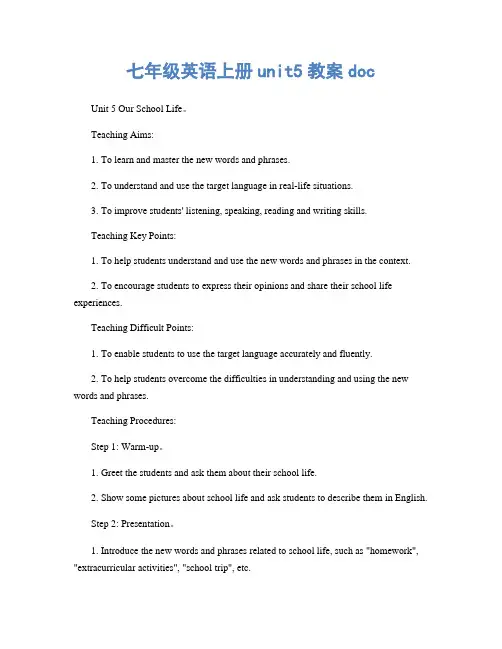
七年级英语上册unit5教案doc Unit 5 Our School Life。
Teaching Aims:1. To learn and master the new words and phrases.2. To understand and use the target language in real-life situations.3. To improve students' listening, speaking, reading and writing skills.Teaching Key Points:1. To help students understand and use the new words and phrases in the context.2. To encourage students to express their opinions and share their school life experiences.Teaching Difficult Points:1. To enable students to use the target language accurately and fluently.2. To help students overcome the difficulties in understanding and using the new words and phrases.Teaching Procedures:Step 1: Warm-up。
1. Greet the students and ask them about their school life.2. Show some pictures about school life and ask students to describe them in English.Step 2: Presentation。
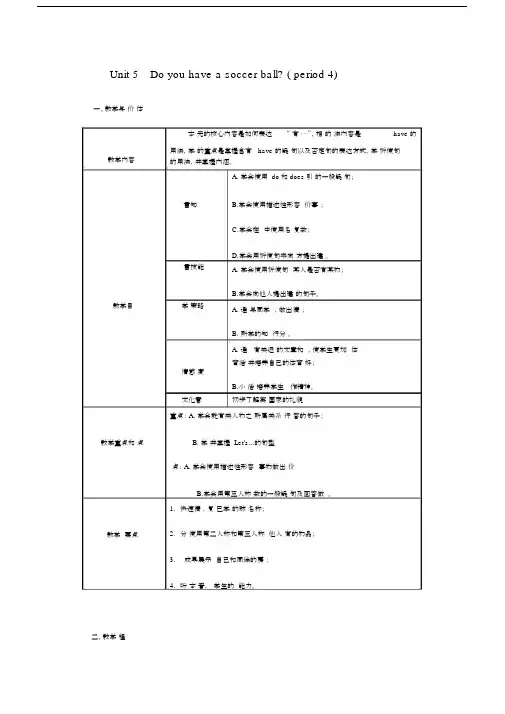
Unit 5 Do you have a soccer ball? ( period 4) 一、教学与价体教学内容本元的核心内容是如何表达“ 有⋯⋯”,相的法内容是have 的用法,学的重点是掌握含有 have 的疑句以及否定句的表达方式,学祈使句的用法,并掌握内涵。
A. 学会使用do 和 does 引的一般疑句;言知 B.学会使用描述性形容价事;C.学会在中使用名复数;D.学会用祈使句来向方提出建。
言技能 A. 学会使用祈使句某人是否有某物;B.学会向他人提出建的句子。
教学目学策略A. 通与同学,做出猜;B.所学的知行分。
A. 通有关运的文章和,使学生更加体育活并培养自己的体育好;情感度B.小活培养学生作精神。
文化意初步了解英国家的礼貌重点: A. 学会就有关人物之所属关系行答的句子;教学重点和点 B. 学并掌握 Let's...的句型点: A. 学会使用描述性形容事物做出价B.学会用第三人称数的一般疑句及回答做。
1.快速猜,复已学的球名称;教学要点2.分使用第二人称和第三人称他人有的物品;3.成果展示自己和同伴的房;4.听本音,学生的能力。
二、教学程教学过程教学内容学生要学会就有关人物之间所属课前关系进行回答的句子评价活动Guessing game: 步骤快速抢答评价活动设计1.听说训练:老师快速展示球类运动,学生猜词。
2.学生通过小组成员互助的形式预习表示球类的名称3.运用所学语言进行对话4.叙述文段T:Let's play a guessing game.What's this?设计意图通过课前查字典,及音标识词参与小组活动,调动学生学习的主动性、积极性。
复习巩固球类的名称,承上启下,为下面的环节作铺垫。
1步骤2 Practice a shortdialogue:复习使用第一人称询问对方是否拥有某种物品S1: Basketball.T: How about this one?S2: Volleyball.S1: Do you have a ...?S2: Yes, I do.S1: Where is the...?S2: It's...S1: Do you have a ...?S2: No, I don't.用实物创设新情景,进一步复习本课的重点句型。
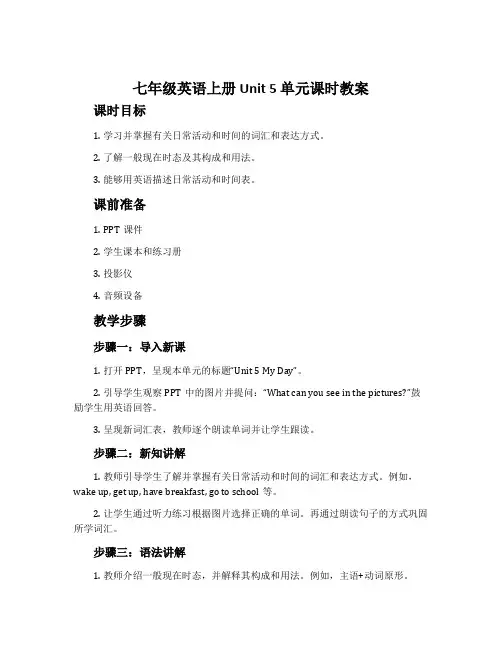
七年级英语上册 Unit 5 单元课时教案课时目标1.学习并掌握有关日常活动和时间的词汇和表达方式。
2.了解一般现在时态及其构成和用法。
3.能够用英语描述日常活动和时间表。
课前准备1.PPT课件2.学生课本和练习册3.投影仪4.音频设备教学步骤步骤一:导入新课1.打开PPT,呈现本单元的标题“Unit 5 My Day”。
2.引导学生观察PPT中的图片并提问:“What can you see in the pictures?”鼓励学生用英语回答。
3.呈现新词汇表,教师逐个朗读单词并让学生跟读。
步骤二:新知讲解1.教师引导学生了解并掌握有关日常活动和时间的词汇和表达方式。
例如,wake up, get up, have breakfast, go to school等。
2.让学生通过听力练习根据图片选择正确的单词。
再通过朗读句子的方式巩固所学词汇。
步骤三:语法讲解1.教师介绍一般现在时态,并解释其构成和用法。
例如,主语+动词原形。
2.通过例句和练习,引导学生了解一般现在时态的用法。
例如,描述经常性的动作和现实情况。
3.运用所学的词汇和一般现在时态,学生在小组内互相介绍自己的日常活动。
教师鼓励学生使用完整的句子进行描述。
步骤四:听说训练1.播放相关录音,让学生跟读和模仿录音中的句子和对话。
2.教师根据学生水平和掌握情况,设计有关日常生活的对话并要求学生表演。
鼓励学生多用一般现在时态来描述。
步骤五:课堂练习1.发放练习册并指导学生独立完成练习。
2.教师巡回检查学生的练习,并适时给予指导和帮助。
步骤六:课堂总结1.规定一般现在时态的构成和用法。
2.让学生自主总结本课所学内容,并将重点内容写在黑板上。
课后作业1.完成练习册中相关练习。
2.进一步练习所学的词汇和句型,例如编写日记或用一般现在时态描述自己的家人、朋友。
小结本课主要教授了有关日常活动和时间的词汇,以及一般现在时态的构成和用法。
通过听说训练和练习册的巩固,帮助学生掌握并运用所学知识。
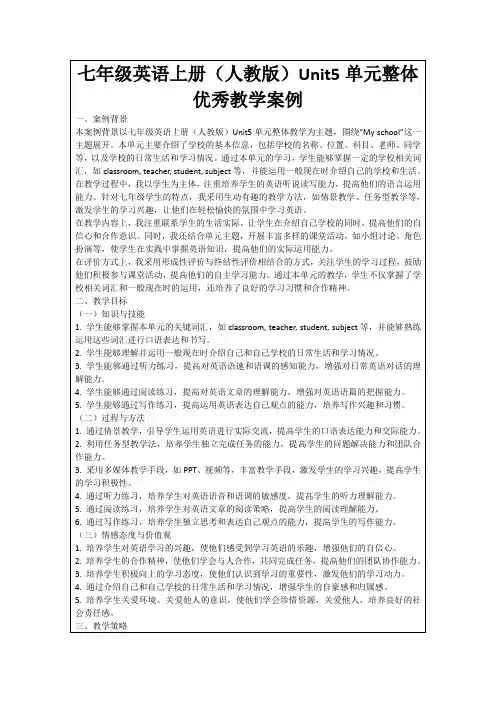
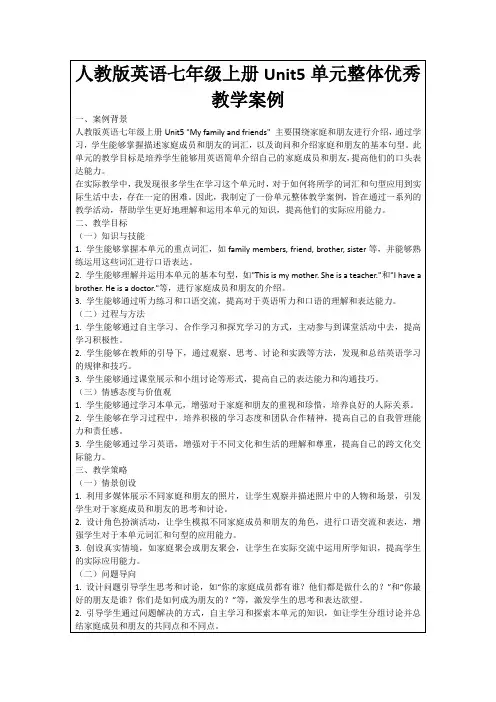
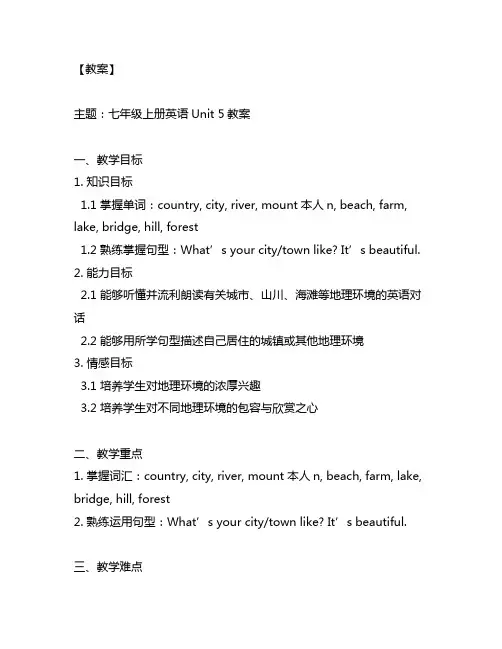
【教案】主题:七年级上册英语Unit 5教案一、教学目标1. 知识目标1.1 掌握单词:country, city, river, mount本人n, beach, farm, lake, bridge, hill, forest1.2 熟练掌握句型:What’s your city/town like? It’s beautiful.2. 能力目标2.1 能够听懂并流利朗读有关城市、山川、海滩等地理环境的英语对话2.2 能够用所学句型描述自己居住的城镇或其他地理环境3. 情感目标3.1 培养学生对地理环境的浓厚兴趣3.2 培养学生对不同地理环境的包容与欣赏之心二、教学重点1. 掌握词汇:country, city, river, mount本人n, beach, farm, lake, bridge, hill, forest2. 熟练运用句型:What’s your city/town like? It’s beautiful.三、教学难点1. 运用句型描述不同地理环境2. 区分并正确使用词汇country和city四、教学准备1. 教学课件2. 多媒体设备3. 课堂小道具:图片、地图等五、教学过程1. Warm-up (5分钟)1.1 看图片说单词:展示地理环境的图片,让学生说出对应的英文单词,如river, mount本人n, beach等1.2 地理环境词汇梳理:用表格形式列出地理环境相关的词汇,让学生逐一朗读并做简单解释。
2. Presentation (15分钟)2.1 授课词汇:通过课件和多媒体设备向学生介绍地理环境相关的词汇,并加以解释和例句。
3. Practice (30分钟)3.1 组内对话:将学生分组,让他们互相练习用英语描述自己所居住的城镇或其他地理环境。
3.2 句型操练:老师示范问句“What’s your city/town like?”,学生回答并做相关补充。
4. Production (30分钟)4.1 小组展示:每个小组选择一处不同的地理环境,用英语对其进行描述,并做简单的展示给全班同学。
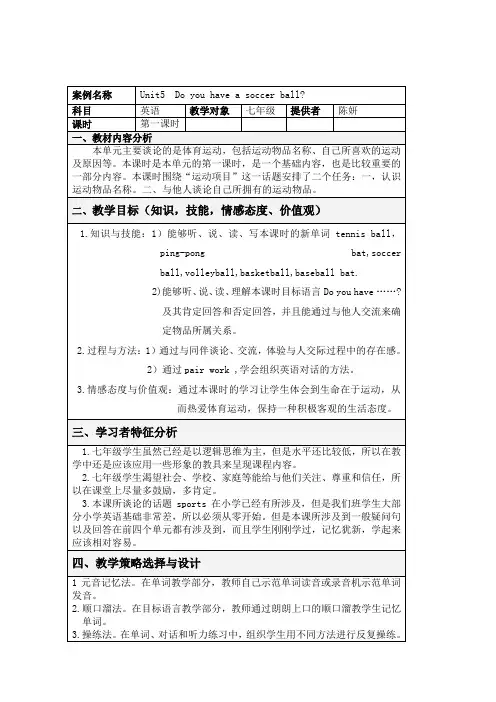
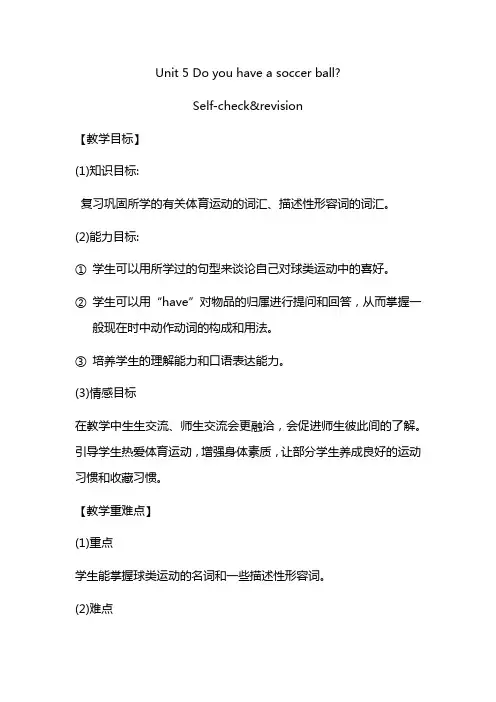
Unit 5 Do you have a soccer ball?Self-check&revision【教学目标】(1)知识目标:复习巩固所学的有关体育运动的词汇、描述性形容词的词汇。
(2)能力目标:①学生可以用所学过的句型来谈论自己对球类运动中的喜好。
②学生可以用“have”对物品的归属进行提问和回答,从而掌握一般现在时中动作动词的构成和用法。
③培养学生的理解能力和口语表达能力。
(3)情感目标在教学中生生交流、师生交流会更融洽,会促进师生彼此间的了解。
引导学生热爱体育运动,增强身体素质,让部分学生养成良好的运动习惯和收藏习惯。
【教学重难点】(1)重点学生能掌握球类运动的名词和一些描述性形容词。
(2)难点学生能掌握一般疑问句的用法。
【教学过程】Step 1 Lead-inAfter greeting students, show them a video and ask students”what can you see in this video?”Yes,you can see a man playing soccer.”Do you like soccer?”“Do you likesports”?Today we are going to review unit5 .Step 2 review the sports wordsShow students some pictures and lead them to review different sports and sports things .Bingo宾果游戏1. Draw a sudoku.2. Write down nine sports things you know.3. Answer my questions and circle the words you hear.When the words are circled in a line, please hands up and say “Bingo”!Step 3Review descriptive adjectivesFind the words in the unit.Write them in the correct column.(小狗吃骨头),Then students write down the adjectives in the chart and use “ I think playing……..is ………..”to practice the sentence.I think playing……..is ………..Step 4Ask and answer questions according to the pictures. (Does he have a soccer ball?No,he doesn’t.Does he have a basketball? Yes,he has a basketball.) Step 5 Homework.complete the questions and answers.1、A: Does your mom have a baseball bat?B: Yes, my mom has a baseball bat.2、A: Do you have a volleyball?B: Yes,I do.3、A: Does your father have a soccer ball?B: Yeah, my father has a soccer ball.4. A: Does your mom have a tennis ball?B: No, she doesn't. My teacher has a tennis ball.。
七上unit5语法教案一、教学目标。
1. 知识目标,学生能够掌握英语中的现在进行时态的构成和用法。
2. 能力目标,学生能够运用现在进行时态进行口头和书面表达。
3. 情感目标,培养学生对英语学习的兴趣,激发学生学习英语的自信心。
二、教学重难点。
1. 教学重点,现在进行时态的构成和用法。
2. 教学难点,现在进行时态的特殊用法及常见错误的纠正。
三、教学过程。
1. 创设情境,导入新课。
通过图片、视频、故事等形式,引导学生进入现在进行时态的学习氛围,激发学生的学习兴趣。
2. 理解规律,掌握构成。
(1)现在进行时态的构成,be动词(am/is/are)+动词的现在分词。
(2)引导学生通过例句和练习掌握现在进行时态的构成规律。
3. 掌握用法,进行巩固练习。
(1)现在进行时态的基本用法,表示现阶段正在进行的动作或状态。
(2)引导学生进行口头和书面练习,巩固现在进行时态的基本用法。
4. 拓展应用,提高语言运用能力。
(1)现在进行时态的特殊用法,表示现阶段的临时性动作、表示不满或抱怨、表示未来安排等。
(2)通过例句和情景对话,引导学生理解并运用现在进行时态的特殊用法。
5. 错误纠正,巩固知识点。
分析学生在现在进行时态运用中常见的错误,进行适当的纠正和巩固。
6. 练习评价,检测学习效果。
设计现在进行时态的练习题,进行课堂练习和作业布置,检测学生对所学知识的掌握程度。
四、板书设计。
现在进行时态的构成,be动词(am/is/are)+动词的现在分词。
基本用法,表示现阶段正在进行的动作或状态。
特殊用法,表示现阶段的临时性动作、表示不满或抱怨、表示未来安排等。
五、课后作业。
1. 完成课堂练习题。
2. 仿照例句,写出5个现在进行时态的句子。
3. 阅读一篇短文,找出其中的现在进行时态,并理解其用法。
六、教学反思。
通过本节课的教学,学生能够掌握现在进行时态的构成和基本用法,并能够初步运用现在进行时态进行口头和书面表达。
在教学中,需要注意引导学生理解现在进行时态的特殊用法,并对常见错误进行及时纠正,以提高学生的语言运用能力。
英语课堂教学设计案例What’s the matter? (Section A)教学分析1.教学内容本单元(七年级上册Unit5)围绕身体健康展开教学活动介绍should等词语来给出建议,旨在培养学生听、说、读、写、译的能力。
2.教材分析及处理本课时的教学内容有以下几个方面需要注意:(1)词汇量很大。
(2)目标语言分散。
(3)活动内容较少。
(4)听力材料不条理,2a难度较大。
鉴于以上几点的考虑,根据学生的认知特点和教学的实际情况,对教材的内容进行了一些调整:(1)身体部位的单词整体呈现,加强记忆。
(2)去掉1a和1b的内容,设计一个游戏活动。
(3)将2a和2b的听力内容整合在一起,调整听力顺序。
(4)将3a、3b和4 中的内容设计成调查表,让学生进行调查并作报告。
3.教学目标:知识目标:1、能够掌握身体部位和疾病的单词。
hand,neck,back,head,toothache, headache…2、能够正确表达我们身体的不适。
I have a headache/stomachache/toothache/sore throat/…能力目标:能够正确谈论身体的健康状况并给出合适的建议。
You should/ shouldn’t …情感目标:学会照顾自己,关心他人,做一个有爱心的人。
教学设计1.总体思路本课采用任务型教学法,同时借助多媒体教学。
游戏和竞赛贯穿于整个教学过程,使学生始终保持浓厚的兴趣。
通过设计讨论、表演、调查等多项活动,增添课堂教学的趣味性和互动性,培养学生的参与意识和实践能力。
2.教学过程StepⅠWarming-upSing If you are happy together.StepⅡ. Leading—inShow the parts of body and read them together.Then play a game. Touch your nose.Ste pⅢPresentationPoint at my headT: What’s this?S: head.T: Yes.Mime an illness.T: What’s the matter? Oh, I’m not feeling well. I have a headache.---I have a toothache.---I have a sore throat.整体呈现所有身体疾病,领读生词。
人教版七年级上册英语Unit 5单元整体教学设计Unit 5 Do you have a soccer ball?一、单元内容分析本单元围绕“Spending time with friends -talking about sports ”这一话题,展开形式多样的听、说、读、写等学习活动。
通过学习运动相关词汇及描述性词汇和学习用Do you have...?句型来谈论自己物品归属和对于运动的喜好和原因。
通过本单元的学习,学生学会谈论、询问和描述物品所属关系,能够表达自己对体育活动的看法并简要说明理由,理解体育锻炼和身体健康的关系,鼓励学生和朋友一起锻炼,共度美好时光。
培养学生乐于交际、提高学生多元文化意识和跨文化交际的能力。
二、单元内容框架单元主题:Spending time with friends - talking about sports Lesson 5 阅读 了解Frank, Gina 和Wang Wei 的运动装备,日常运动和对运动的看法。
Lesson 6 写作 介绍自己和同伴的日常体育活动、运动装备和对体育运动的观点和看法。
了解体育活动和装备,学会询问体育装备的归属,激发学生对体育活动的兴趣。
热爱体育活动,保持身体健康,和朋友们享受体育活动带来的乐趣用所学语言谈论对体育运动的看法并简要说明原因,理解体育活动和身体健康的关系,合理安排体育活动,和朋友们共度体育活动的美好时光。
谈论对体育活动的看法,合理安排体育活动,保持身体健康,与朋友共度运动的美好时光。
Lesson1&2听说 谈论体育装备以及归属,激发学生对体育运动的兴趣。
Lesson 3 语法 学习have 一般现在时的表述,学习询问体育装备的归属和答语。
Lesson 4 听说 学习描述性形容词的用法,表达对体育活动的观点和看法。
写一篇短文介绍自己和同伴的日常体育活动、运动装备和对体育运动的观点和看法,和朋友一起运动,共度美好时光。
七年级上册集体备课U n i t5教学案-CAL-FENGHAI.-(YICAI)-Company One1新目标英语七年级(上)Unit 5 Do you have a soccer ball教材分析本单元是七年级上正式篇第五单元。
本单元分为四个部分:Section A、Grammar Focus、Section B 和Self check。
在这一单元中,学生要学会就有关人与物之间所属关系进行问答的句子。
本单元大量引入有关运动的名词,要求学生彼此询问有关此类物品,并作出相应的回答。
同时学习表示建议的句型Let’s 及表示评价各种运动的形容词。
本单元所选用的话题来自于学生所喜爱的生活片段,在教学中生生交流、师生交流会更融洽,会促进师生彼此间的了解,成功的教学还会让部分学生养成良好的运动习惯和收藏习惯。
Period 1: Section A (1a-2c)I.双向细目表II.教学过程IV、练题一.根据句意用所给单词的适当形式填空。
1.The___________(dictionary) are in the bookcase.2.Does your father________(like) sports3.Can you help _______(I)4.Let’s_______(play) soccer ball.5.They have two__________(computer)二.单项选择。
1.-Does your brother ______any baseballs-Yes, he ____some.A.has, has , have , has2.--Do you have any erasers---No, we ______.A.aren’t ’t ’t3.The music is like it.A.well4.Peter likes sports very much,_______he doesn’t like soccer.A.and5.Many people _______TV in the evening.A.look at三.根据所给单词及标点提示连词成句。
1.doesn’t, Alice, sports, play ________________________________2.Play, games, computer, let’s _________________________________3.Have, a , hat, collection, I , great__________________________________4.His, have, mother, uncle, an, does _________________________________5.Only, them, I, on, TV, day, watch, every ____________________________ Period 2 : Section A (2d-3c)I.双向细目表II.教学过程IV、练题一、单项选择。
1.Let’s play_________baseball.A.aB./2.There are five people in a _______team.A.basketball3.--Where are your tennis ball--_________.A.They are under the bed.B. They are in the pencil box.C. Do you have tennis ball4.--Let’s play computer games.---________.A.Well. Let’s play soccer. , I don’t. C. That sounds good.5.--Who is your pen friend--________.A.No, it’s my cousin.B. Yes, it’s my brother.C. I don’t have a pen friend.二.根据下列汉语意思翻译句子。
1.She likes____________(体育运动) very much.2.__________(让我们) play tennis.3.Sue has two_____________(篮球).4.My brother___________(看) TV every day.5.That music__________(听起来)good.6.Do you want to __________(加入) the English club三.翻译句子。
1.你有网球吗没有,但是彼得有。
________________________________________________________2.让我们去打篮球吧!________________________________________________________3.安没有棒球,她不喜欢打棒球。
________________________________________________________4.那听起来不错!________________________________________________________Period 3: Section B (1a-1d)I.双向细目表II.教学过程IV、练题一.根据句意和首字母提示完成句中所缺的单词。
1.He doesn’t play sports, he only w________ them on TV.2.--Let’s watch TV. --No,it’s b________.3..Math is very d_________ for me, so I don’t like it.4..Yao Ming is a great Chinese b________ player.5.--Let’s play ping-pong. --That s________ good.二.在方框中选择恰当的词语完成下面对话。
A:________play computer game!B: That sounds ________, ________ I don’t have a ________.A: Well, ______ you have a volleyballB: Yes.A: Then let’s ________ volleyball.B: Oh, volleyball is so_________.A: Ok, let’s watch TV.B: That sounds _______. Let’s play ________. Do you have a soccer ball三.句型变变变。
1.Jeff has lunch at school.(改为一般疑问句)_________________________________________2.They have an English class every day.(改为否定句)They_______ ________ an English class every day.3.It’s a tennis racket.(改为复数句)_______ are tennis_________.4.Are those your books(改为单数句)_________________________________________5.he, ball, a, does, have, soccer, () (连词成句)_________________________________________四.选词填空。
John is sixty-six. But he looks young. He _1_ two children, one is a son and the other _2_ a daughter. He has ten tennis racket, eight baseballs, 6 basketballs, 12soccer balls and 18 volleyballs. But he never plays sports. He only _3_ collecting thing. His son , Neal, likes soccer. He is a number of the city soccer club. He plays soccer every day with his friends. And his daughter, Nancy, likes volleyball. But she_4_ it. She _5_ it on TV.Period 4:Section B(2a-2c)I.双向细目表II.教学过程IV、练题一.根据句意和所给汉语提示完成句子。
1.Tom ______(有)some English books.2.This is an__________(有趣的)game.3.We have many football_______(俱乐部) in China.4.Do you have a _________(网球)racket5.I have five_________(排球).二.根据短文内容,选择正确答案。
I have three good friends. We like sports very much. My favorite sport is basketball. I have three balls. I think playing basketball is interesting. Jim and Tim think it is boring to play basketball. Their favorite sport is soccer ball. They play soccer every afternoon. They have four balls. Mary is a nice girl. Her favorite sport is volleyball. She plays it very well. It’s relaxing for her to play volleyball. But she has only one ball. Sports are good for us.1.What’s Jin and Tim’s favorite sportball2.What’s Mary’s favorite sport ________.3.Who has only one ball4.Does Mary think it’s boring to play soccer, she does , she doesn’t C. We don;t know.5.How many balls do I have三.任务型阅读。